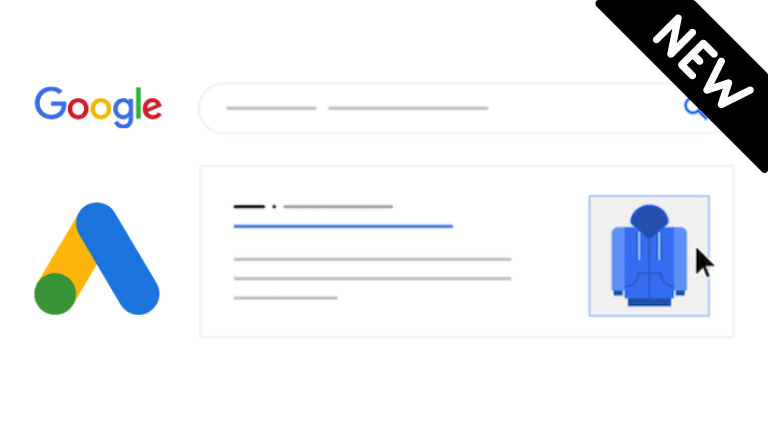Believe us when we say, “a picture is worth a thousand words.” This is because humans are visual creatures. In fact, the human brain can process visuals up to 60,000 times faster than text. So It’s not surprising that users prefer a combination of visuals and text for ads they are exposed to.
What is an image extension?
Ad extensions are additional elements to your Google ads that allow you to provide further information or call-to-actions to reinforce your message and encourage people to click through. Image extensions enable advertisers to show images next to Google search ads.
For example, an ad that might be encouraging people to learn more about Peter Singer can have an image of Peter Singer beside the ad text. In this case, people interested in knowing more about Peter Singer don’t have to waste time browsing Peter Singer on the search engine.

Image extensions help contribute to the ad overall quality score of the keywords.
Quality score is a combination of click-through rate, keyword relevancy in each ad group, landing page quality and relevance, ad text relevancy and historical Google Ads account performance.
Ads with higher quality scores rank higher on search engine result pages and could result in a higher ad ranking and lower cost per click.
The performance of image extensions will also rely on keyword and ad copy strength. The higher the relevancy of both keyword and ad copy, the higher the click-through rate, improving the ad ranking.
Relevance is significant for all ad elements, keywords, ad copy, and landing pages. Why? Because Google wants to give people what they are looking for. When people find the search results relevant, they are pleased, encouraging continued use of the service. Continued use of the service means increased advertising demand and revenue.
How do image extensions work?
When your ads appear on the Google search results page, image extensions are shown to the right of the ad’s headline, description, and URL. You should pick images best tailored to both your brand and target audience.
Currently, image extensions are exclusively for mobile devices. A square image appears on all Google.com. There are no alternative size options; the same square will show for every image extension (full image specs are shown later in this article).
As users are more mobile-centric these days, it is well worth incorporating image extensions on your ads to drive more mobile traffic.
Remember that an image extension will perform best when relevant to the search queries. It might affect the ad’s quality score if the image selected does not appear relevant or match the experience that the searcher will find on the landing page.
The benefits of using image extensions
It’s no secret, you give people what they want, and you’ll get a better response. Image extensions can help drive performance for advertisers by appealing to our visual nature.
Adding image extensions to active campaigns improves the visibility of the ads on search engine results pages (SERPs). As a result, ads are getting more clicks, an increase in click-through rate, and potentially more conversions. From our own experience, we have seen a gradual improvement in both clicks and click through rate (CTR) in our Google Grant accounts since we implemented image extensions. The CTR increased from 3.38% in November 2021 to 6.7% in January 2022.
Requirements to use image extensions
To utilise image extensions, your Google Ads account must meet the following criteria or risk being disapproved:
- A good history of policy compliance
- A Google Ads account in an eligible vertical or sub-vertical. (Sensitive topics such as sexual content, alcohol, gambling, and healthcare aren’t suitable for image extensions)
- An open account that has been operating for more than 90 days
- An account with active campaigns
- Running active search campaigns with text ads.
Image Specifications & Requirements
Image Type: static GIF, PNG, JPG
Note: Image file sizes cannot exceed 5120 KB.
Aspect ratio:
| Aspect ratio | Where can it show | Required |
| Square (1×1) | Google.com, YouTube search via AdSense For Search (Search Partners) | Yes |
| Landscape (1.91×1) | YouTube search via AdSense For Search (Search Partners) | Optional, but recommended |
Image resolution:
| Aspect ratio | Minimum pixels | Recommended pixels |
| Square (1×1) | 300 x 300 | 1200 x 1200 |
| Landscape (1.91×1) | 600 x 314 | 1200 x 628 |
Reference: Google Advertising Policies Help
Image Extensions Best Practises
- Place the most essential content in the centre (80%) of the image
- Your image extensions should be informative, high resolution and highly relevant to the audience that you are targeting
- Use 3-4 images in your campaign even though you can include up to 20 images per campaign or ad group
- Use both square (1×1) and landscape (1.91×1) ratio images.
Image Extensions – Things to Avoid
- Using an image that has too much black space
- Using blurry/low-resolution images
- Using visually skewed or distorted images
- Using poorly cropped images (if you want to use cropped images, make sure photos are trimmed in a way that the subject of the asset is easily identifiable)
- Images with text or graphic overlay including brand logo/ brand logo being used in the image asset
- Using images with text that has been overlaid on top of the image
- Using multiple images that are combined
- Using sexually suggestive images or images that contain nudity
Image extensions are here to stay, and they’re proving to be a valuable tool for Google Ad Grant performance.
If you are looking to maximise this opportunity, speak to a Ninja!
If you are looking to maximise this opportunity, speak to a Ninja!
Please get in touch if you need help with the day-to-day management of your Google Ad Grant, paid Google Ads account, or some other area of your digital marketing.












